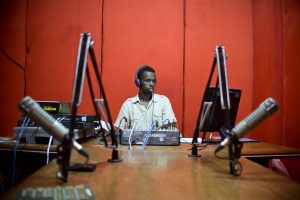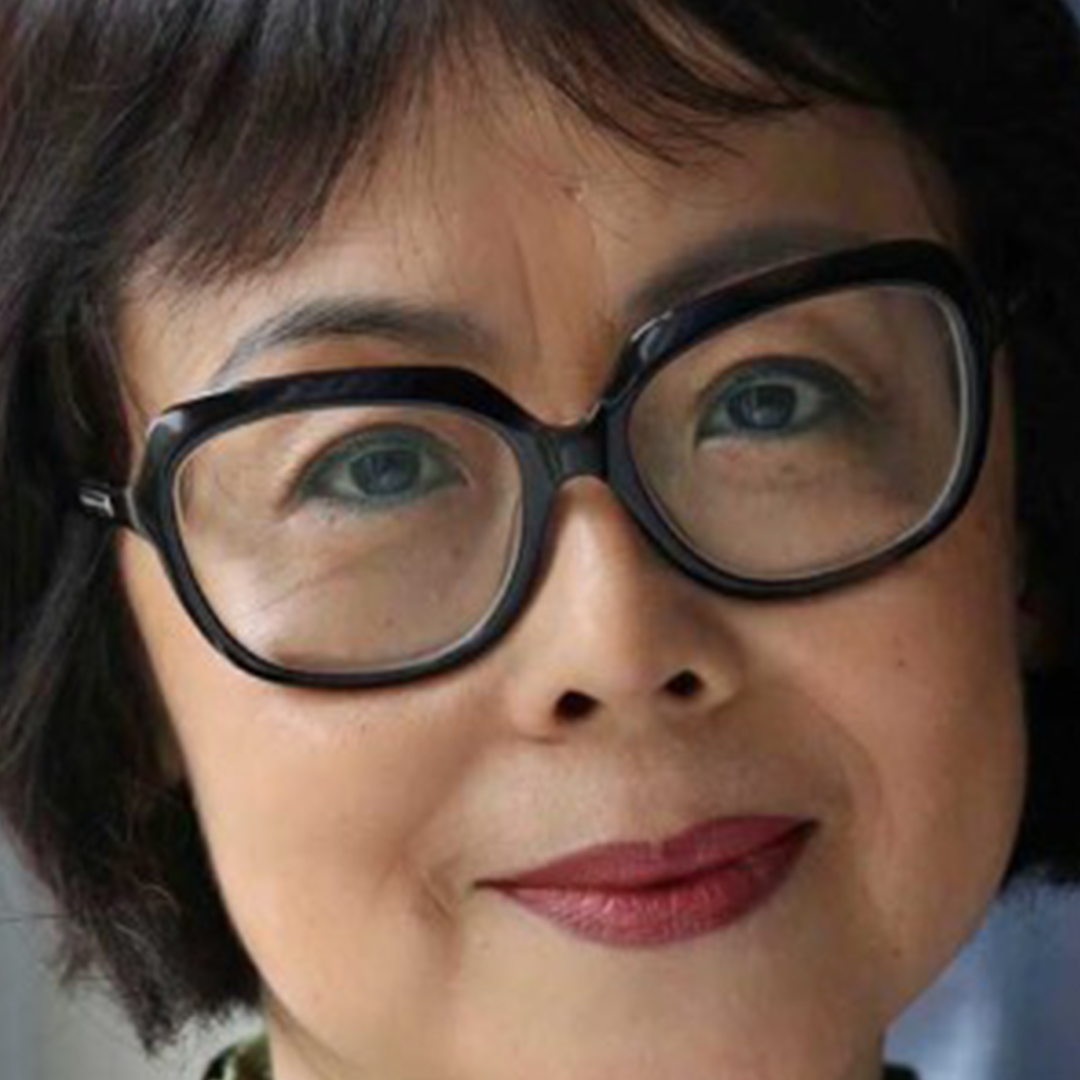9 Jan 2018 | Journalism Toolbox Spanish
[vc_row][vc_column][vc_custom_heading text=”Los guerreros islamistas de Al Shabab controlan una quinta parte de Somalia y tienen su propia emisora de radio. Ismail Einashe habla con los periodistas que arriesgan su vida retransmitiendo noticias sobre las actividades del grupo terrorista”][vc_row_inner][vc_column_inner][vc_column_text]

Un periodista retransmite desde Radio Shabelle, una de las populares emisoras de Mogadiscio (Somalia), que corren peligro por pronunciarse contra la organización terrorista Al Shabab, Amisom Public Information/Flickr
[/vc_column_text][/vc_column_inner][/vc_row_inner][/vc_column][/vc_row][vc_row][vc_column][vc_column_text]
Cada mañana, antes de ir a trabajar en Radio Kulmiye, en el centro de Mogadiscio, Maruan Mayu Huseín tiene que comprobar que no haya bombas en su coche. «Miro debajo de las ruedas, pero normalmente ponen las bombas debajo del asiento», dice. «Si me paro en algún lado de la ciudad, entonces tengo que volver a mirar, porque a veces me sigue gente».
Los periodistas somalíes como Huseín viven bajo la amenaza constante del poderoso grupo islamista Al Shabab, estrechamente relacionado con Al Qaeda. Para el grupo, colocar una bomba debajo del asiento de un coche y detonarla a distancia es marca de la casa a la hora de matar a periodistas somalíes. Huseín lo confirma: «Conozco gente muerta y herida por culpa de las bombas que les habían colocado en el coche».
Periodistas como Hindia Hayi Mohamed, madre de cinco hijos, han sido víctimas de esta táctica de Al Shabab. Trabajaba para Radio Mogadiscio y la Televisión Nacional Somalí, dos medios estatales de noticias, cuando un coche bomba la mató a las puertas de la embajada turca en Mogadiscio el 3 de diciembre de 2015. Los integrantes de Al Shabab que la asesinaron habían colocado una bomba bajo el asiento de su coche. Era la viuda de Liban Ali Nur, director de los informativos de la Televisión Nacional Somalí y fallecido en la explosión de un atentado suicida de Al Shabab en septiembre de 2012, junto a otros tres periodistas, en una popular cafetería de la capital.
Los periodistas de radio como Huseín son vulnerables cuando salen de su casa, pues es fácil acribillarlos por la calle. Huseín es reportero para una popular emisora local que retransmite noticias a las partes sur y central de Somalia. Como cuenta a Index: «Si Al Shabab os ve a vosotros, no os dejan pasar. Si me ven a mí, me matan. Trabajar como periodista radiofónico en Somalia es muy duro. El problema es hoy puede haber un ataque terrorista aquí y, mañana, en cualquier otro lado».
La radio sigue siendo el principal medio de la gente para informarse y enterarse de las noticias en Somalia. Hay pocos periódicos impresos y un bajo índice de alfabetización. El somalí solo pasó a ser una lengua escrita en 1972 y, a causa de la guerra civil, no se publican muchos libros en el país. Internet es popular, pero se trata de un fenómeno en su mayoría urbano, especialmente entre los jóvenes y los que han vuelto de la diáspora. Los informativos de televisión existen, pero el acceso a televisores es limitado en uno de los países más pobres del mundo. Por todo ello, la radio sigue siendo crucial. Laura Hammond, experta en Somalia de la Facultad de Estudios Orientales y Africanos de la Universidad de Londres, explica: «La somalí es una cultura oral, y la transmisión de información a través de la radio es una extensión de la antigua tradición de la oración y el intercambio de información por medio de la poesía y la palabra hablada».
Las fuentes radiofónicas que gozan de mayor prestigio son el canal somalí de la BBC, que hace poco celebró su sexagésimo aniversario, y el servicio somalí de Voice of America. Pero al comunicar al público las noticias sobre lo que está pasando en su país, los periodistas somalíes se exponen a una violencia e impunidad de las más terribles en el continente africano. En el Índice de Libertad de Prensa de 2017 realizado por Reporteros sin Fronteras, Somalia ocupa el puesto 167 de 180.
[/vc_column_text][/vc_column][/vc_row][vc_row][vc_column width=”1/4″][/vc_column][vc_column width=”3/4″][/vc_column][/vc_row][vc_row][vc_column][vc_column_text]
Mohamed Ibrahim Moalimuu, el secretario general del Sindicato Nacional de Periodistas Somalíes, nos lo cuenta: «Somalia sigue siendo uno de los peores países para operar como periodista, una profesión que a menudo está en el punto de mira. Son víctimas de intimidaciones constantes, arrestos arbitrarios, tortura y, en ocasiones, asesinato».
Algunos periodistas somalíes se han visto forzados a esconderse por las amenazas continuadas que reciben de Al Shabab. Un periodista al que entrevistó Index, y que quiso permanecer anónimo por razones de seguridad, cuenta: «Mi vida está patas arriba desde que Al Shabab empezó a darme caza […] Al Shabab me llama desde números desconocidos y me dice: “Tu vida está peligro.”»
El periodista es un conocido reportero de radio que cubre noticias sobre el grupo armado. Añade: «He recibido amenazas de Al Shabab. Escucharon mis reportajes sobre sus ataques terroristas y desde entonces me han amenazado de muerte». Lleva dos años ocultándose de ellos, temiendo por su vida.
En febrero de 2017, unos operativos de Al Shabab visitaron la casa de su madre. Relata: «Fueron a casa de mi madre. Le preguntaron: “¿Dónde está?” Ella les dijo que no estaba allí y le dijeron a mi madre: “La próxima vez que veas a tu hijo, estará muerto.” Le tiembla la voz al contarlo. Hoy, exhausto de pasar los días oculto de las balas de Al Shabab, añade: «Quiero recuperar mi vida, pero soy un periodista joven que vive bajo amenaza […] No puedo dejar de ser periodista. No dejaré de usar mi voz».
Según Angela Quintal, coordinadora de programación para África en el Comité para la Protección de los Periodistas, 62 de ellos han perdido la vida en Somalia desde 1992. Más de la mitad de ellos (43 en total) fueron asesinados, con Al Shabab bajo sospecha de ser responsable de la mayoría de las muertes. Pese a que los asesinatos de periodistas han disminuido desde 2012, en 2016 mataron a tres.
Los antecedentes son que, tras el colapso del estado somalí y la guerra civil de 1991, el país se sumió en una orgía de violencia y terrorismo, a lo que se añade una sequía reciente de efectos devastadores. En el vocabulario de la política internacional, Somalia era conocida como «el estado más fallido» del mundo, pero en los últimos años ha dado paso a la expresión «estado frágil». De entre todas las amenazas a las que ha hecho frente Somalia, Al Shabab, posiblemente la organización terrorista más potente de África, se lleva la palma.
En los últimos años, Al Shabab ha perdido algunos territorios en partes del sur de Somalia, como el puerto estratégico de Kismayo, así como mucho territorio en Mogadiscio. Pero aún controla amplias franjas de territorio en el país.
Al Shabab no solo ataca a periodistas radiofónicos somalíes, sino que tiene su propia emisora, llamada Al Ándalus, desde la que retransmiten propaganda yihadista con música devocional islámica, así como estridentes informativos sobre los “kafirs”, o infieles, y cuántos de ellos han matado. La emisora cuenta con un amplio alcance en las partes meridionales de Somalia y en las áreas bajo su control, y está disponible en internet.
Moalimuu dice que Al Ándalus aún funciona y emite en áreas controladas por Al Shabab.
Mary Harper, editora de BBC África e inmersa en la escritura de un libro sobre Al Shabab, afirma que las actividades radiofónicas de la organización terrorista les lleva «siglos de ventaja a Boko Haram».
En lo que respecta a sus ataques a civiles, al gobierno o a las fuerzas de la Unión Africana, según Harper, ofrece una visión bastante fidedigna, pero tiende a exagerar el número de muertos que provoca. Utilizan Al Ándalus como instrumento para suprimir la libertad de expresión y extender su propaganda radical islamista.
Moalimuu dice: «Al Shabab prohíbe la música en todas las áreas que aún controlan. Vigilan los teléfonos móviles de los jóvenes regularmente. Los smartphones y cualquier otro tipo de móvil con cámara están prohibidos en sus territorios. Esta norma sigue aún vigente en todas las áreas controladas por Al Shabab. La gente está muy frustrada, pero no les queda otra opción que obedecer si quieren seguir con vida».
Nur Hasán, un periodista y productor audiovisual retirado de Mogadiscio, explica: « Al Shabab prohíbe la música terminantemente. Si te pillan escuchando música en las zonas bajo su control, el castigo son 40 latigazos y la humillación pública».
Harper apunta que no todas las amenazas provienen de Al Shabab: «Los periodistas de Somalia están amenazados por todas las esquinas».
Pero Huseín sigue preocupado por la amenaza del grupo terrorista. Dice que algunos periodistas de radio están tan preocupados que pasan algunas noches en el estudio en lugar de dormir en sus camas. Él, por su parte, lo tiene claro: «No me preocupará la muerte hasta que venga a por mí». Hasta entonces, dice: «Seguiré mirando que no haya bombas cuando salgo de casa, pero mi destino está en manos de Dios».
[/vc_column_text][/vc_column][/vc_row][vc_row][vc_column][vc_column_text]
Ismail Einashe escribe reportajes regularmente para la revista Index on Censorship desde el Cuerno de África. Nació en Somalilandia y es miembro académico del Dart Center de la Universidad de Columbia con una beca Ochberg.
Este artículo fue publicado en la revista Index on Censorship en otoño de 2017.
Traducción de Arrate Hidalgo.
[/vc_column_text][/vc_column][/vc_row][vc_row content_placement=”top”][vc_column width=”1/3″][vc_custom_heading text=”Free to Air” font_container=”tag:p|font_size:24|text_align:left” link=”url:https%3A%2F%2Fwww.indexoncensorship.org%2F2017%2F12%2Fwhat-price-protest%2F|||”][vc_column_text]Through a range of in-depth reporting, interviews and illustrations, the autumn 2017 issue of Index on Censorship magazine explores how radio has been reborn and is innovating ways to deliver news in war zones, developing countries and online
With: Ismail Einashe, Peter Bazalgette, Wana Udobang[/vc_column_text][/vc_column][vc_column width=”1/3″][vc_single_image image=”95458″ img_size=”medium” alignment=”center” onclick=”custom_link” link=”https://www.indexoncensorship.org/2017/12/what-price-protest/”][/vc_column][vc_column width=”1/3″ css=”.vc_custom_1481888488328{padding-bottom: 50px !important;}”][vc_custom_heading text=”Subscribe” font_container=”tag:p|font_size:24|text_align:left” link=”url:https%3A%2F%2Fwww.indexoncensorship.org%2Fsubscribe%2F|||”][vc_column_text]In print, online. In your mailbox, on your iPad.
Subscription options from £18 or just £1.49 in the App Store for a digital issue.
Every subscriber helps support Index on Censorship’s projects around the world.
 SUBSCRIBE NOW[/vc_column_text][/vc_column][/vc_row]
SUBSCRIBE NOW[/vc_column_text][/vc_column][/vc_row]
19 Sep 2017 | Events, Volume 46.03 Autumn 2017 Extras
[vc_row][vc_column][vc_column_text]

Free to air is the autumn 2017 edition of Index on Censorship magazine
Join Index on Censorship magazine for the launch of the autumn 2017 celebrating all things radio.
In conjunction with our friends at Resonance FM, Index will be broadcasting all evening on Tuesday 10 October, as we discuss the rebirth of radio and why it is so important to freedom of expression.
Special guests include Jamie Angus, deputy director of the BBC World Service Group, broadcaster and DJ Tabitha Thorlu-Bangura from NTS Live, broadcaster and sound artist Fari Bradley from Resonance FM and writer and broadcaster Mark Frary, who will also be running a short DIY podcasting workshop before the panel discussion.
We’re launching the magazine with its special report Free to Air: Why the Rebirth of Radio is Delivering More News at the iconic Tea Building in Shoreditch, home to digital product studio ustwo, our venue partners for the launch. Features in the latest magazine include a 98-year-old granny making grassroots radio in the USA, radio journalists in Somalia who brave danger to do their jobs and the Spanish comedians who make a television show about a radio station.
There will be drinks from Flying Dog Brewery, our freedom of expression chums and sponsors and we’ll be closing the evening with a DJ set from Resonance FM’s very own Nana Nicol.
6:00 – 6:30 DIY podcasting workshop, register for your free space via [email protected]
6:30 – 7:15 drinks
7:15 – 8:30 Panel discussion
8:30 – 9:00 DJ set from Nana Nicol
Many thanks to:[/vc_column_text][vc_row_inner][vc_column_inner width=”1/3″][vc_single_image image=”95760″ img_size=”full” onclick=”custom_link” link=”https://resonancefm.com/”][/vc_column_inner][vc_column_inner width=”1/3″][vc_single_image image=”80918″ img_size=”full” onclick=”custom_link” link=”https://uk.sagepub.com/”][/vc_column_inner][vc_column_inner width=”1/3″][vc_single_image image=”95897″ img_size=”full” onclick=”custom_link” link=”https://ustwo.com/”][/vc_column_inner][/vc_row_inner][/vc_column][/vc_row][vc_row][vc_column][vc_column_text]
When: Tuesday 10 October 18:30 to 21:00
Where: ustwo London, 62 Shoreditch High Street, London E1 6JJ
Tickets: Free. Registration required via Eventbrite
[/vc_column_text][/vc_column][/vc_row]
12 Sep 2017 | Magazine, Magazine Editions, Volume 46.03 Autumn 2017
Journalist
Amie Ferris-Rotman is an award-winning journalist, based in Moscow, who currently writes for Foreign Policy. She previously reported for The Wall Street Journal and Reuters from across Russia and the former Soviet Union
Writer and radio presenter
Xinran is a popular radio personality in China, who had a call-in programme named Words on the Night Breeze from 1989 to 1997. She is also the author of several bestselling books, including The Good Women of China, China Witness and Buy Me the Sky.
Writer
Peter Bazalgette is executive chairman of ITV and former chair of Arts Council England. He is author of The Empathy Instinct: How to Create a More Civil Society (John Murray), which was published in January 2017.
12 Sep 2017 | Magazine, Magazine Contents, Volume 46.03 Autumn 2017
[vc_row][vc_column][vc_custom_heading text=”Contributors include Madeleine Thien, Xinran, Peter Bazalgette, Laura Silvia Battaglia, Mahesh Rao, Chawki Amari and Amie Ferris-Rotman”][vc_column_text]
The retro medium of radio is back, as we explore in the Autumn issue of Index on Censorship magazine 2017, which is excellent news for the delivery of well, news. Laura Silvia Battaglia reports from Mosul on the radio station that is giving a voice to the people there, while Claire Kopsky interviews people behind “radio boats“, boats that are broadcasting information on cholera in the Central African Republic in a bid to educate the population about the disease.
[/vc_column_text][vc_single_image image=”95458″ img_size=”full” alignment=”center”][/vc_column][/vc_row][vc_row][vc_column][vc_column_text]
Then there are the examples of radio proving a perfect outlet for people to share their most private inner thoughts and experiences, as Wana Udobang writes about from a Nigerian context and Xinran remembers back in China.
Part of the increased popularity of radio is that it’s managed to evolve and we have an article on how podcasts are being made in some of the least likely – and most censored – places, such as China, and smuggled into North Korea. We also have a handy guide on making your own podcasts, for those with an idea.
But radio’s ability to reach the masses also means that this powerful tool can get into the wrong hands. Ismail Einashe explores this in his article on al-Shabaab in Somalia, who operate a very popular radio station. Then there’s Rwanda, which two decades ago saw the airwaves being monopolised by voices promoting genocide. The country has moved on a lot, but radio is still far from free.
Outside the special report, we take you to Russia where a seemingly innocent film about the last tsar has angered the country’s church. With Banned Books Week coming up, we ask a selection of writers to choose the books that made them think most about free speech. What would be your pick? And we have an extract from a forthcoming novel highlighting the dangers of being a journalist in Mexico, with superb illustrations to accompany.
Finally, don’t miss our cut-out-and-keep male nipple template, a handy tool to ensure female nipples are social media friendly.
[/vc_column_text][/vc_column][/vc_row][vc_row][vc_column][vc_custom_heading text=”Special report: Free to air “][vc_column_text]
Why the rebirth of radio is delivering more news
Fear for the airwaves, by Ismail Einashe: In Somalia al-Shabaab control a prominent radio station and a fifth of the country. Meet the radio presenters who brave danger to keep reporting
Project freedom? by Sally Gimson: Radio Free Europe was at the frontline of Cold War reporting. Three decades on, is it still needed?
Sound unbound, by Oleg Shynkarenko: How a new radio station was built from scratch using crowdfunding to break away from oligarchs and government pressure
Don’t touch that dial, by Kieran Etoria-King, Rachael Jolley, Jemimah Steinfeld: Interviews with a pirate rain DJ, comedian Robin Ince, a Hong Kong presenter, the controller of BBC World Service English and the editor of a refugee radio station
Syrians speaking, by Rhodri Davies: Syrians in exile on why they set up a new radio station and what it covers
Power to the podcast, by Mark Frary: Podcasting is bringing a whole new audience to radio and giving investigative journalism a boost. Plus, our handy guide to making your own podcasts
Stripsearch cartoon, by Martin Rowson: There’s a new app out called Smart Ink. Will it become a dictator’s favourite tool?
Tuning into a brave new world, by Jan Fox: Grassroots radio is on the rise in the USA, where a 98-year-old granny is a station superstar, but it’s not without challenges
Under the rad(io)ar, by Kaya Genç: A radio station in Turkey, known for its criticism of the government, is somehow surviving the current crackdown
Taboos and telephones, by Xinran: Radio was one of the first outlets where Chinese women spoke about personal issues such as forced abortions. Is the same honesty possible today?
Stationed in the warzone, by Laura Silvia Battaglia: Radio presenters in Mosul tell Index how the station is giving a voice to the people, but it has not been easy operating under bombardment
Secrets, lies and Lagos lives, by Wana Udobang: Exorcisms and illicit affairs are just some of the topics callers to a popular talk show in Nigeria wanted to share
New waves, by Claire Kopsky: Radio took to riverboats in the Central African Republic to bring information and news about a cholera epidemic
Chat rooms, by Milton Walker: Talk about interactivity, Jamaican radio shows sometimes receive as many as 4,000 text messages
Sound and fury, by Graham Holliday. Two decades ago Rwandan radio was monopolised by voices promoting genocide, but radio is still not free from controversy
Let’s get this show on the road, by Silvia Nortes: Meet the Spanish comedians behind Radio Gaga, a television show about radio which visits overlooked communities
[/vc_column_text][/vc_column][/vc_row][vc_row][vc_column][vc_custom_heading text=”In focus”][vc_column_text]
China’s other great wall, by Madeleine Thien: 1980s Beijing saw the creation of another wall, one promoting democracy. The Booker Prize nominee discusses its legacy today
Closing access to the back door, by Iona Craig: Investigative journalists working in hostile environments need encrypted apps to work more safely. This is being forgotten in the current debate on encryption
No one owns language, by Jemimah Steinfeld: The 2016 Man Booker Prize winner Paul Beatty discusses “offensive” language and teaching styles
Risky business, by Charlotte Bailey: Amid confiscations and threats, one chain of bookstores continues to operate in Libya
Tracking down the F word in fiction, by Mahesh Rao, Sean Gallagher, Kieran Etoria-King, Grainne Maguire, Ryan McChrystal: Ahead of Banned Books Week, writers choose the books that make them think about free speech
Costume drama, by Amie Ferris-Rotman: Russia’s religious right claim God is annoyed about a film on the last tsar, just part of a new censorship culture
Bulldozing his way through the media, by Natasha Joseph: Tanzania’ current president has been nicknamed “the bulldozer” and the media is in his sight
Big brother we’re watching you, by Jason Daponte: Members of a new, hip London club claim to have empowered voters in the UK General Election
Making a killing, by Duncan Tucker: A special Index investigation looking at why Mexico is an increasingly deadly place to be a journalist as reporters face threats from corrupt police to deadly drug gangs
New tribal instinct, by Peter Bazalgette: Our pact mentality has become more pronounced as we spend more time online, the author argues
[/vc_column_text][/vc_column][/vc_row][vc_row][vc_column][vc_custom_heading text=”Culture”][vc_column_text]
Parallel lives and unparalleled risks, by Tim MacGabhann: The author discusses his time reporting from Mexico, how the death of one journalist particularly affected him and introduces an excerpt from his forthcoming book
The people’s poet, by Wiji Thukul: Nearly 20 years since Indonesia’s famous poet disappeared, Eliza Vitri Handayani introduces the man and some new translations of his poems
The disappeared, by Chawki Amari: The award-winning Algerian writer talks about prison in Algeria and the media landscape in France. Plus a short story
[/vc_column_text][/vc_column][/vc_row][vc_row][vc_column][vc_custom_heading text=”Column”][vc_column_text]
Index around the world, by Kieran Etoria-King: Top comedy acts discuss the importance of humour following our event Stand up for Satire, plus news of other Index summer highlights
[/vc_column_text][/vc_column][/vc_row][vc_row][vc_column][vc_custom_heading text=”Endnote”][vc_column_text]
Uncovering the nipple cover-up, by Jemimah Steinfeld: The battle to give the female nipple equal rights as one woman heads to the Supreme Court. Plus, a cut-out-and-keep male nipple for social media use
[/vc_column_text][/vc_column][/vc_row][vc_row content_placement=”top”][vc_column width=”1/3″][vc_custom_heading text=”Free to air” font_container=”tag:p|font_size:24|text_align:left” link=”url:%20https%3A%2F%2Fwww.indexoncensorship.org%2F2017%2F09%2Ffree-to-air%2F|||”][vc_column_text]Through a range of in-depth reporting, interviews and illustrations, the autumn 2017 issue of Index on Censorship magazine explores how radio has been reborn and is innovating ways to deliver news in war zones, developing countries and online
With: Ismail Einashe, Peter Bazalgette, Wana Udobang[/vc_column_text][/vc_column][vc_column width=”1/3″][vc_single_image image=”95458″ img_size=”medium” alignment=”center” onclick=”custom_link” link=”https://www.indexoncensorship.org/magazine”][/vc_column][vc_column width=”1/3″ css=”.vc_custom_1481888488328{padding-bottom: 50px !important;}”][vc_custom_heading text=”Subscribe” font_container=”tag:p|font_size:24|text_align:left” link=”url:https%3A%2F%2Fwww.indexoncensorship.org%2Fsubscribe%2F|||”][vc_column_text]In print, online. In your mailbox, on your iPad.
Subscription options from £18 or just £1.49 in the App Store for a digital issue.
Every subscriber helps support Index on Censorship’s projects around the world.
 SUBSCRIBE NOW[/vc_column_text][/vc_column][/vc_row]
SUBSCRIBE NOW[/vc_column_text][/vc_column][/vc_row]

![]() SUBSCRIBE NOW[/vc_column_text][/vc_column][/vc_row]
SUBSCRIBE NOW[/vc_column_text][/vc_column][/vc_row]



